Symmetry in Photography: A Basic Guide for Better Compositions
![]()
Wherever you are right now, take a moment to look around. What patterns and shapes do you see? What objects, scenes, buildings, or other designs just look like they “make sense?”
You’re noticing symmetry, where one half of something is the mirror image of the other half. It’s extremely common in everyday life because the brain is wired to find symmetry pleasing. This is one of the reasons that many buildings, cars, clothes, and even foods have symmetry.
It also happens to be a very important part of composition in photography. That is, it’s a very important part of how a photograph is arranged or put together. Symmetry can be used in just about any type of photography, and it’s a valuable tool that can greatly enhance your compositions. This article will explore symmetry from many different angles in the context of photography.
Table of Contents
Types of Symmetry in Photography
There are a few different types of symmetry, and exploring all of them will help diversify the way you compose images. It’s important to understand that the different types of symmetry are named based on their lines of symmetry. This means that different types of symmetry are defined by the lines (and sometimes shapes) that create the symmetrical pattern.
![]()
Something else to consider is that symmetry can exist at many different levels. In architecture photography, for example, lines of symmetry are often very well-defined and the symmetry is very clear. In other instances, such as wildlife or landscape photography, symmetry can exist without perfection. For example, many landscapes with reflections can be horizontally symmetrical, even if their top and bottom sides aren’t perfectly identical down to the millimeter.
Horizontal Symmetry
![]()
This type of symmetry occurs when a horizontal line passes through an image to make two upper and lower mirror halves. In this case, a horizontal line is the axis of symmetry. In photography and other art, this is most common in images of reflections. Lakes or ponds can create an entirely symmetrical image, while puddles or even water droplets can create horizontal symmetry in just part of an image.
![]()
If you really want to play with horizontal symmetry, the next time you find a puddle (or make one on your own), get your camera as close to it as you can. Play with the perspective and try to make it appear that you’re next to a lake. If you can make the reflection created by the puddle take up the entire foreground of your image, you can often give the illusion that it’s a large body of water. It helps if there’s no wind to create ripples on whatever body of water you’re using, but you can sometimes get away with a slight breeze.
![]()
![]()
![]()
Vertical Symmetry
![]()
Vertical symmetry occurs when a vertical line creates two left and right mirror halves. This type of symmetry often shows up in animals, other aspects of nature, and tools (such as instruments). Humans generally have vertical symmetry, which is also called bilateral symmetry in biology (bi- meaning two, and lateral meaning side). It’s also common in architecture, as many buildings have vertically symmetrical front sides.
![]()
One common way to create vertical symmetry in your compositions is by using paths or roads. Never put yourself or others in danger, but using road lines or paths extending into the distance to divide your image into left and right halves is a simple way to add vertical symmetry. Really, any leading line can create some sort of vertical symmetry.

Vertical symmetry can often be found in cities by looking up. Skyscrapers extending into the sky, lamp posts, and even power lines provide vertically symmetrical compositions. All you need to create an element of vertical symmetry is some sort of line to bisect the image vertically and two sides that are somewhat identical.
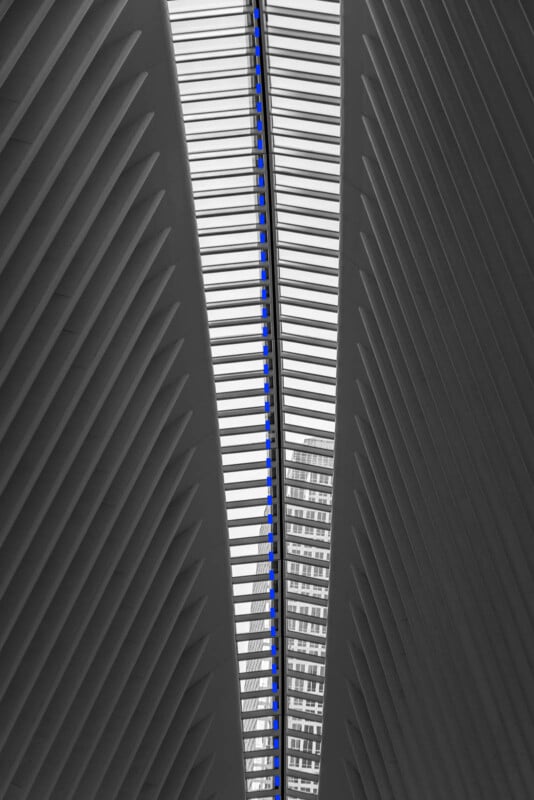
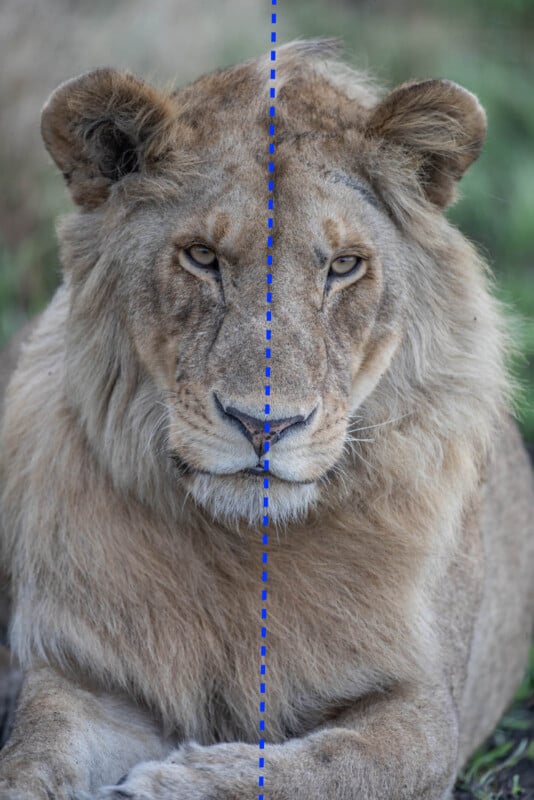
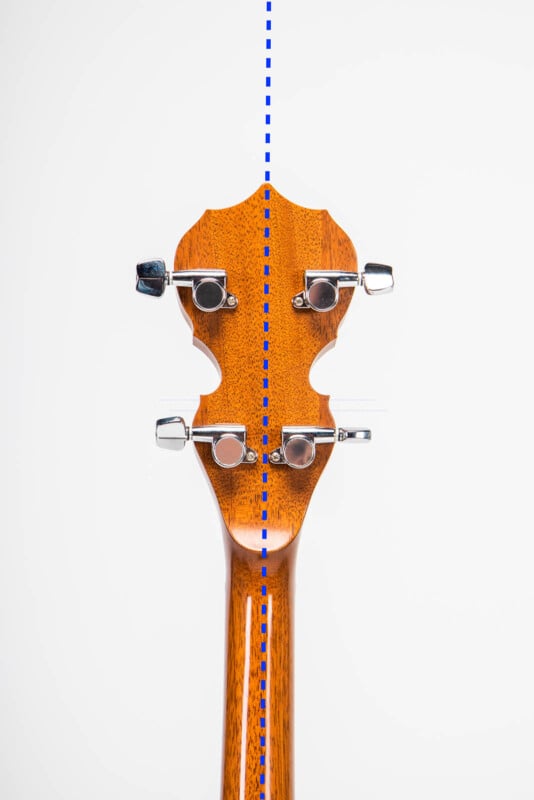
Radial Symmetry

Instead of using a line to create symmetry, a central point can act as the point of symmetry. Radial symmetries are less likely to be perfect in nature, but they can still contribute greatly to enhancing a composition. Many flowers and eyes have natural radial symmetry. Domed structures also tend to have radial symmetry from the top and inside.
Since radial symmetry is somewhat difficult to find, challenge yourself to create unique images by using radial symmetry. Anything that makes the viewer’s eye follow a circle to a center point likely has some aspect of radial symmetry.
Other Types of Symmetry
Horizontal, vertical, and radial aren’t the only types of symmetry. Since symmetry is a concept defined by lines and shapes, just about any line or shape could make some sort of symmetry. Get creative! For example, images can have diagonal symmetry if the line of symmetry divides the image into two mirror halves diagonally.

Gear for Using Symmetry in Photography
Ultimately, you don’t need much other than a camera and a careful eye to use symmetry in your compositions. However, if you want to create perfectly symmetrical images, there are a few pieces of camera equipment that might help.
1. A sturdy tripod and a good ball head. This will help you finely adjust your composition to capture the scene as you intend to. Tripods also help you keep your image still and free of camera shake when you activate the shutter, which helps with consistency.
2. A bubble level. If your tripod head doesn’t already have one of these built in, bubble levels are very useful when trying to get lines of symmetry to be straight. If your camera is perfectly parallel to a horizontal line of symmetry, then your image will have horizontal symmetry. Some cameras also have built-in levels, although they’re not always the easiest to use. Check with your camera’s manual to see if your camera can help you level your image itself.
3. A lens with low amounts of distortion (although this can usually be corrected). Symmetry relies on lines being mostly straight for the compositional elements to work well together. Lenses with high amounts of distortion can still capture symmetry, but it’s not always as clean as intended. The best lenses to capture symmetry have low amounts of distortion. If you do have some distortion, this can usually be corrected in a post-processing software such as Adobe Lightroom.
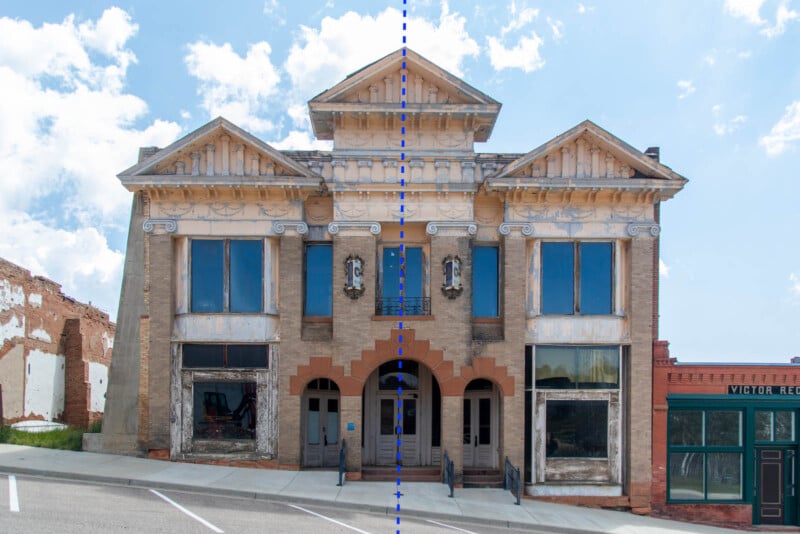
Creating Artificial Symmetry
Especially with the increasing power of computational photography using smartphone cameras and apps, artificial symmetry can also be fun to experiment with. Smartphone apps such as KaleidaCam and MirrorArt will add artificial symmetry to your smartphone’s camera. These apps are especially fun because you can change the pattern of symmetry and find what looks most interesting. This is a fun way to take an ordinary scene and transform it into something unique. These apps also allow you to play with different symmetrical patterns in videography, which can be a great creative outlet.
Another option for creating artificial symmetry is by using post-processing software such as Photoshop. Image transformations and rotations allow you to create symmetry out of any scene, even though it won’t always look natural. Think of this as a way to get creative with your images when you can’t be out shooting.
Learning from the Opposite: Asymmetry
Now that you’ve learned about symmetry in photography, it’s important to give some thought to compositional possibilities when purposefully not using symmetry. Asymmetry – that is, having two halves of your image be unequal purposefully – can add interesting elements to an image.
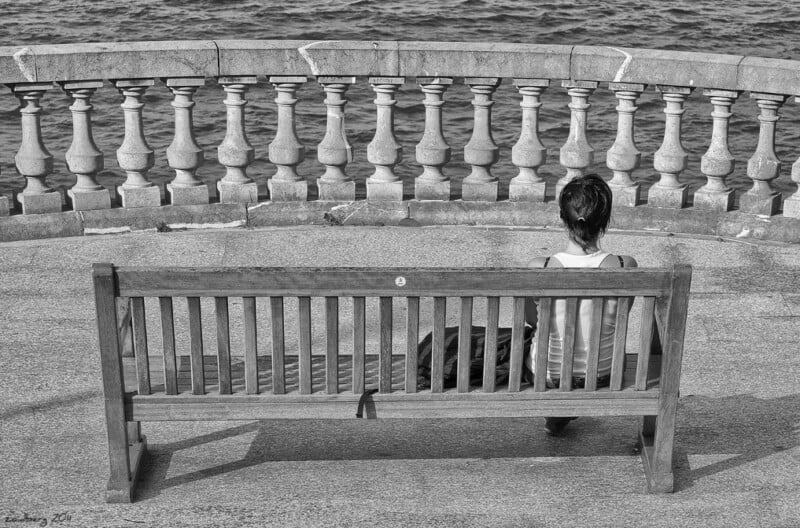
Asymmetry may direct the viewer to look more at one side or another. It could also direct their minds to try to create symmetry in the image if the two sides are similar, yet clearly not symmetrical. This makes the image more appealing because the brain feels challenged in trying to form a pattern. Asymmetry is typically most powerful when there are distinct “sections” in an image, and one of those sections takes priority over the rest.
While symmetrical compositions tend to be clearly eye-catching and pleasing, asymmetry can also add a unique sense of unrest or emphasis to images. Next time you’re out photographing, challenge yourself to purposefully shoot with symmetry and without. Compare what effects the symmetrical images might have on a viewer versus the effects the asymmetrical images might have. Are the symmetrical ones more calm and in-place? Does asymmetry seem more obscure and on-edge, or something else? Compositional exercises like this don’t require much in terms of subject matter, and they’ll help you develop compositional skills for your future photography endeavors.
Conclusion
We’re so used to symmetry in our daily lives that we sometimes forget to use it purposefully in photography. Whether you’re photographing architecture, landscapes, people, wildlife, or just about anything else, symmetry can add compositional complexity to your images that will make them stand out. If everyone’s taken the same picture of a mountain range, why not try to photograph it with some element of symmetry to show a unique perspective?
Better yet, utilize both symmetry and asymmetry in your photography. Then, you can decide which composition conveys your intended meaning best. Becoming a better photographer often starts with composition, and being aware of symmetry in your compositions is a guaranteed way to start making better images.
Image credits: Header photo by Michael Zhang. All other photos, unless otherwise noted, by Justin Hein